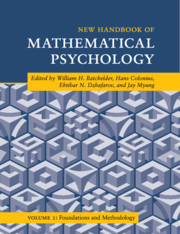Book contents
- Frontmatter
- Contents
- List of contributors
- Preface
- 1 Selected concepts from probability
- 2 Probability, random variables, and selectivity
- 3 Functional equations
- 4 Network analysis
- 5 Knowledge spaces and learning spaces
- 6 Evolutionary game theory
- 7 Choice, preference, and utility: probabilistic and deterministic representations
- 8 Discrete state models of cognition
- 9 Bayesian hierarchical models of cognition
- 10 Model evaluation and selection
- Index
4 - Network analysis
Published online by Cambridge University Press: 01 December 2016
- Frontmatter
- Contents
- List of contributors
- Preface
- 1 Selected concepts from probability
- 2 Probability, random variables, and selectivity
- 3 Functional equations
- 4 Network analysis
- 5 Knowledge spaces and learning spaces
- 6 Evolutionary game theory
- 7 Choice, preference, and utility: probabilistic and deterministic representations
- 8 Discrete state models of cognition
- 9 Bayesian hierarchical models of cognition
- 10 Model evaluation and selection
- Index
Summary
Introduction
The history of network analysis can be traced back to the Book of Genesis and the list of who “begat” whom (Freeman, 2004). More recently, in 1851 Lewis Henry Morgan, one of the founders of American anthropology, found that tribes of native Americans, such as the Iroquois and Ojibwa, had a consistent system of naming relatives that was entirely different from European nomenclature. The Iroquois and Ojibwa system has a feature called bifurcate merging, which means that the same word is used for “father” as for “father's brother” (i.e., they are merged), while distinct words are used meaning “father's brother” and “mother's brother” (they are bifurcated; Morgan, 1851/1997).
Modern network analysis started in the 1930s as an attempt to formally capture with a diagram of nodes and edges between nodes the more nebulous interpersonal relationships among members of a social group. Moreno (1934) invented the sociogram as a data structure to represent relationships between pairs of members of a well-defined set. For example, the set might consist of members of an elementary school, and the relationships might be necessarily reciprocal such as playing together or being enrolled in the same class, or not necessarily reciprocal such as expressing friendship toward or receiving advice from. From a mathematical perspective, a sociogram is a type of graph (described formally later), and soon after Moreno's and other's work, the area of sociometry was established. Later, the interdisciplinary area of social networks flowered, which Freeman (2004) characterized by the following properties:
• intuition based on ties linking social actors,
• systematic empirical data,
• graphic imagery,
• mathematical and/or computational models.
Since the late 1990s, there has been an explosion of interest in networks of all kinds, e.g., neural networks, health-related networks, economic networks, semantic networks, as well as networks in computer science, physics, sociology, and psychology. In fact, the term network science is well-established today, and it refers to a rapidly growing interdisciplinary area that reaches well beyond the areas of sociometry and social networks. There has been a confluence of forces that have led to the explosion of interest in network science. First, there have been substantial recent increases in mathematical, computational, and statistical tools that can be used to analyze networks. Second, on the empirical side, through the Internet and related information technologies, it has become possible to collect very large sets of network data.
- Type
- Chapter
- Information
- New Handbook of Mathematical Psychology , pp. 194 - 273Publisher: Cambridge University PressPrint publication year: 2016

